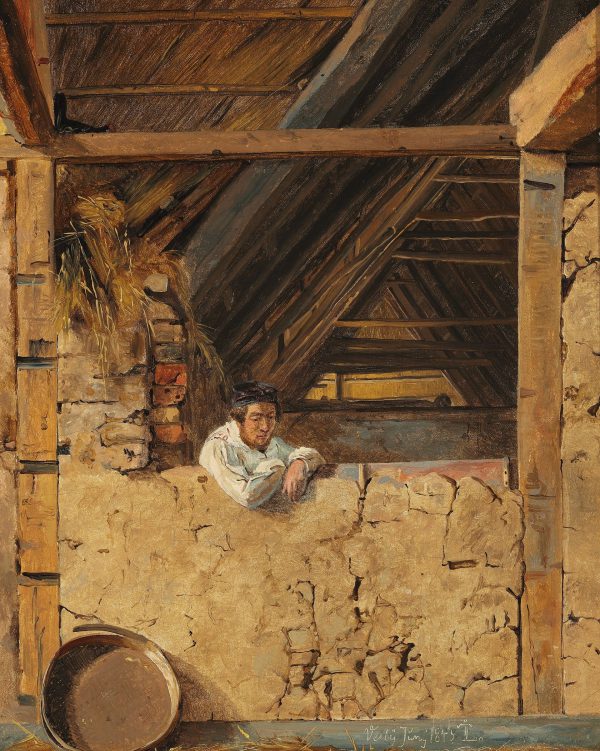Peter Christian Skovgaard leaning against a low Wall in a Barn, 1843
Oil on paper laid down on canvas, H. 0.34 m; W. 0.28 m
Signed with a monogram, situated and dated lower right: Veiby Juny 1843 TL.
Provenance: Baron Stampe, Nysø (1895).
The collection of Johan Hansen, Consul General, his sales, part IX, Winkel & Magnussen 139, 1933 no. 113, reproduced p. 17.
Private collection, Denmark.
Carl Madsen, Johan Thomas Lundbye 1818-1848, Copenhagen, 1949, p.182, no. 143.
Hailed during his lifetime as the most important Danish Romantic landscape artist, Lundbye seems to have escaped Eckersberg’s influence. From the age of twelve, he was trained by Johan Ludwig Lund, who had been close to Caspar David Friedrich and the German Nazarene painters in Rome. He later had animal painter Christian Holm as a teacher. Admitted to the Academy of Copenhagen in 1833, Lundbye became friends with Laessøe and P.C. Skovgaard. During those years, Købke’s style and sense of colour had an immense influence on Lundbye, though the Norwegian landscape painter Johan Christian Dahl arguably left an even deeper impression on him soon afterwards. In 1835, he began exhibiting his works at Charlottenborg.
It is considered that he reached his artistic maturity around 1838. In 1842, he began to attend the lectures of art historian N. L. Høyen. He also went to Vartov’s church to listen to the preacher N.F.S. Grundtvig, and Lundbye was marked by his nationalistic Romantic ideas for many years, before moving away from them. In 1845 he received a travel scholarship from the Academy and went to Rome; the trip, however, does not seem to have had much influence on his works. While he was attracted to the ideas of the Nazarenes, he never travelled to Munich, nor did he venture to Dresden, the capital of Friedrich\’s Romanticism.
When the Schleswig-Holstein War broke out in 1848, Lundbye volunteered to join the army. Officially he died from a stray bullet, but the possibility of suicide has also been considered.
In the summer of 1843, Lundbye spent two months with his friend Skovgaard in Vejby, in northern Zealand. Our painting shows his friend in an informal pose creating an intimate atmosphere and using straight lines in a closed perspective arrangement, employing a range of warm golden colours.


